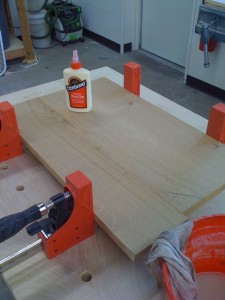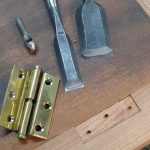We may receive a commission when you use our affiliate links. However, this does not impact our recommendations.
 From time to time I hear someone comment about a woodworking practice that runs totally contrary to what I’ve been taught. One of these is what kind of wood surface yields the strongest joint when using wood glues, typically white or yellow glue, but also hide glue.
From time to time I hear someone comment about a woodworking practice that runs totally contrary to what I’ve been taught. One of these is what kind of wood surface yields the strongest joint when using wood glues, typically white or yellow glue, but also hide glue.
This came up a few weeks ago. And while I thought I was right, that the best surface is smooth, I thought I’d get to the bottom of the question. I mean, maybe I was wrong. So I went to the folks who know a lot about this, Franklin International, makers of the Tite-Bond and lots of other adhesives. I received the following from Bob Behnke, the company’s Senior Technical Specialist. There’s great information here that every woodworker must know. And by the way, the section on Franklin’s web site on woodworking glues is a great resource for woodworkers. You should check it out.
Hi Steve,
Our work has shown that a smooth surface will always have higher strength than a rough surface. Two-hundred grit or higher sanding to get flat or tight-fitting joints works well.
Wood glues work by attaching to cellulose on the wood and the smoother (tighter) the joint, the less adhesive is needed to bond the surfaces. Less adhesive gives fewer areas of imperfections (bubbles, skips, dust and gaps) where stress can accumulate and cause glue line failure. Also, wood glues tend to be around 50% solids and therefore shrink when they dry. If the rough surface is too “gappy,” as the adhesive dries and shrinks, it will pull away from one surface or the other leaving gaps in the glue line, which again will concentrate force when the joint is stressed. This is why wood glues need to be clamped. Clamping keeps the surfaces in contact as the glue shrinks and dries.
A note of caution on smooth surfaces: Burnished areas may be smooth, but will not bond. Burnishing causes the cellulose to change chemical characteristics and thus not bond to the polyvinyl alcohol portion of the wood glue. This can be tested by putting a drop of water on the surface of the wood, if it doesn’t soak in, the surface is burnished or sealed and should be sanded until cleaned of the burnishing.
For hammer veneering, you can use either hot or liquid hide glue. I have read that roughing the surface of the substrate and veneer gives better strength. But our work shows that too much roughing of the surface can cause loose fibers and fiber tear which can weaken the bond. As above, the adhesive bonds to the cellulose so a roughed surface is not necessary, but as long as it doesn’t damage the wood surface to be bonded, it will produce good results on veneers.
Bob Behnke
Sr. Technical Specialist
Guess that settles it. And thanks, Bob.
Want to know more on gluing and clamping? Read a fascinating blog post by executive editor Robert Lang based on an experiment gluing a mortise and tenon joint. You may also want “Glue and Clamps, the Missing Shop Manual,” a 104-page paperback in our store for just $9.95.
Here are some supplies and tools we find essential in our everyday work around the shop. We may receive a commission from sales referred by our links; however, we have carefully selected these products for their usefulness and quality.









Is it possible to Private Message people who post replies here? I guess not, I was hoping to get confirmation from Gluedude, or someone else knowledgeable on this subject. And actually it is partially a question that was already asked. I have a Saga TC-10 guitar kit, the guitar body has a sanding sealer on it (I think I read somewhere that it is a polyester sanding sealer, but I was not able to re-find where I thought I read it so not 100% certain of that). But either way it has a thick coat of some type of sanding sealer, and I want to glue a veneer on it. So can I glue the veneer directly to the sanding sealer, and if so, do I use wood glue or some other type of glue. Or should I sand the sealer off before gluing on the veneer? An answer will be greatly appreciated, I already ruined one veneer attempting this, I think I used too much glue, I ended up with wavy bubbles in the veneer. So I think I used too much glue, but not that I have already messed up one veneer, I want to take extra precautions to make sure I do the next one right. I am very eager to get moving on this so if someone could please give me an answer as soon as possible, it would be greatly appreciated.
Thanks
Heck – I’ll fess up. I was gluing some freshly planed hard maple into panels last week and they seemed too(oo) smooth. Before gluing with TB3 I kissed them with some 400 grit. It made me feel better about the whole thing.
Not a lot of specific info out there (that I have seen, anyway) So – I appriciate the new knowledge!
I’ve worked in the adhesives industry myself and think this is a less than complete answer. There seems to be room for confusion over smooth/rough vs quality of fit. There is a world of difference between a surface that has been sanded vs one that has been planed. Given a choice between the two where strength is critical, I will always take a surface that has been prepared with some form of knife edge over an abrasive.
Quality of fit is another story. Clamping pressure is only needed to overcome gaps between bonding surfaces… Which raises another important point: What is “gappy” to a PVA wood glue? Ideal adhesives spread thickness is between 0.006″ to 0.009″ (6 to 9 mils) and these correlate exactly with the gap filling ability of a PVA. Bob is clearly off on at least one point, the polymers do not bond directly with cellulose. From a strictly technical standpoint, they experience weak electrostatic interactions with the cellulosic interface of wood… Once again, helping to explain why fit is so essential to a strong joint. Beyond 10 mils or so, the PVA starts to behave independently of the joint (ever seen a ridge of glue that started off smooth?)
On another note, good luck finding much polyvinyl alcohol in a wood glue. While it would work fine, products like Titebond are based on polyvinyl acetate instead.
Instead of worrying about burnishing, I’ve found most people want to know more about exotic and oily woods. These follow the same rules with respect to fit and finish, but they are sensitive to other factors. PVA and hide glues are both water based, which is exactly why they have trouble bonding with an oily surface (literally mixing oil and water.) There are two good solutions to this: glue up within two hours or so of planing/sanding the wood or wipe it with acetone prior to bonding.
I have never seen a study on the use of liquid hide glue for hammer on veneer applications. Did Bob elaborate on how this was studied? Liquid hide glues work by using gel point depressant additives, which allow them to remain stable at room temperature. When heated to 110°F to 120°F they start to behave like hot hide glue, and might work under such conditions… But I have never seen or heard of it being tested.
To address some of the questions above:
Always glue to bare wood whenever possible. Sanding sealer will render the surface less porous and can be expected to interfere with the drying process and bond formation.
The reason the question of “roughing up” a joint comes up is that people are under the misconception that doing so will increase the bonding surface area and therefore improve adhesive performance. This is actually true for some 100% solid products such as epoxies.
Polyurethanes like Gorilla glue have similar needs to water based wood glues when wood is the substrate in question. In fact, their performance can be damaged even further by the presence of bubbles in the glueline.
To Steve: You might want to direct your questions in need of an expert elsewhere in the future. I understand Bob has been in the industry for a little over a year and hasn’t worked with wood since junior high shop class. His response seems to support what I’ve heard. If you must go through a company such as Titebond, that may be biased, I suggest you contact a different senior technical specialist… Mark Roberts, who has been with that group for 15 years or so. If you want to avoid industry conflicts of interest, feel free to contact me. I’ve been considering writing a book on the topic of adhesives as they relate to woodworking and have over 20 years of experience in the field. A series of articles could prove to be fun.
I have been assembling some small wood models lately and found a great glue at a hobby shop called Pinewood Formula Gap Filling Glue. I have used it on smooth and rough surfaces and have found no real difference in the bonding. Of course this is small scale, and maybe the gap filling attribute changes things as well.
Hey Steve,
Just to add a word from the world of wooden aircraft, the FAA will not approve a sanded surface for gluing. All surfaces must be freshly cut or planed prior to gluing.
As an old A&P (airframe and power plant) inspector once asked me,
“Do you get better traction on a gravel road, or pavement?”
Tom
What about gluing wood that has had an application of sanding sealer applied? Or should pieces be glued first and then have sanding sealer applied afterwards?
I`m wondering who thought 2 rough surfaces would make for a good glue line? Or was it the differences between glue line rips, versus jointed, vs hand planed edges? Rough makes no sense at all, even with a Bessey as tight as a Bessey will go you would see some gaps on truly rough edges. How could that possibly net you a better joint? Probably the same people who advocate on “fine furniture” sanding no higher than 80 grit for the best finish. Sometimes you just can`t skip a step.
Couple of things to add, coming from boatbuilding and bow making. Best surface is a surface freshly planed with a sharp tool. If the joint is critical, fresh is important in that pollution, mostly in the form of oily particles from car and diesel exhausts, or an oil-burning stove in a shop closed up for the winter can get on the wood and prevent the wet-out, for any glue but for epoxy this can be especially important.
Hi, Steve.
I wonder if that’s also true for polyurethanes like Gorilla Glue?
John